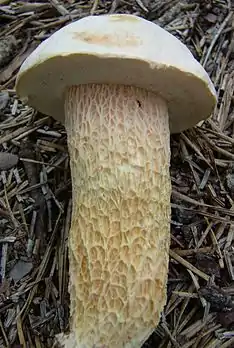| Austroboletus subflavidus | |
|---|---|
 | |
| Scientific classification | |
| Kingdom: | |
| Division: | |
| Class: | |
| Order: | |
| Family: | |
| Genus: | |
| Species: | A. subflavidus |
| Binomial name | |
| Austroboletus subflavidus (Murrill) Wolfe (1980) | |
| Synonyms[1] | |
Austroboletus subflavidus is a species of bolete fungus in the family Boletaceae. It is found in eastern North America, where it fruits near oak and pine trees. Originally described as a species of Tylopilus by American mycologist William Murrill in 1938,[2] it was transferred to the genus Austroboletus by Carl B. Wolfe in 1980.[3] The fruit body has a white to yellowish convex to flattened cap measuring 3–10 cm (1.2–3.9 in) in diameter. The pores on the cap underside, which measure about 1 mm wide, are initially white to grayish before becoming pinkish. The coarsely reticulate and pitted stipe measures 4.5–14.5 cm (1.8–5.7 in) long by 0.7–3 cm (0.3–1.2 in). The spore print is reddish brown; spores are spindle-shaped (fusoid) with dimensions of 15–20 by 6–9 μm.[4]
See also
References
- ↑ "GSD Species Synonymy:Austroboletus subflavidus (Murrill) Wolfe". Species Fungorum. CAB International. Retrieved 2015-01-02.
- ↑ Murrill WA. (1938). "New boletes". Mycologia. 30 (5): 520–5. doi:10.2307/3754346. JSTOR 3754346.
- ↑ Wolfe CB. (1979). Austroboletus and Tylopilus subgenus Porphyrellus, with emphasis on North American taxa. Bibliotheca Mycologica. Vol. 69. p. 67.
- ↑ Bessette AR, Bessette A, Roody WC (2000). North American Boletes: A Color Guide to the Fleshy Pored Mushrooms. Syracuse, New York: Syracuse University Press. pp. 82–3. ISBN 978-0-8156-0588-1.
External links